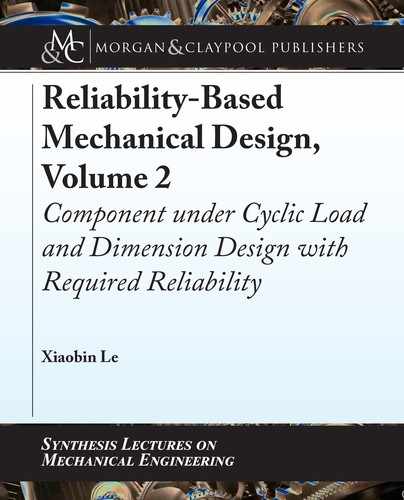
154 3. THE DIMENSION OF A COMPONENT WITH REQUIRED RELIABILITY
Table 3.21: e iterative results for the limit state function (b)
Iterative #
E
*
F
*
L
*
h
*
d
*
|∆d
*
|
1 27,600 25.12 15.25 0.375 2.467504
2 27,299.99 32.63592 15.25001 0.374927 3.241643 0.774139
3 27,210.93 32.54067 15.25001 0.374907 3.242937 0.001295
4 27,210.81 32.54054 15.25001 0.374907 3.242937 4.2E-08
According to the result for the strength issue obtained from the program, the mean of the
height with a reliability 0.99 is
d
D 3:243
00
: (e)
e iterative results for the strength issue are listed in Table 3.22.
Table 3.22: e iterative results for the limit state function (d)
Iterative #
S
y
*
F
*
t
*
d
*
|∆d
*
|
1 34.5 25.12 0.375 1.941643
2 30.37683 31.41671 0.374939 2.758402 0.81676
3 29.41902 30.58276 0.374934 2.772642 0.014239
4 29.40566 30.56907 0.374936 2.772645 3.74E-06
According to the result for the strength issue obtained from the program, the mean of the
height of the plate with a reliability 0.99 is
d
D 2:773
00
: (f)
e heigh d of the plate with the required reliability 0.99 under the specified loading will be
the larger value of Equations (c) and (f). erefore, the heigh d of the plate with the required
reliability 0.99 under the specified loading and deformation requirement is
d D 3:243 ˙ 0:005
00
:
3.3.3 COMPONENT UNDER STATIC DIRECT SHEARING
e limit state function of a component and its reliability calculation under direct shearing for
strength issue have been discussed in detail in Section 4.7 of Volume 1 [1]. After the limit
state function of a component under static direct shearing loading is established, we can run

3.3. DIMENSION OF A COMPONENT UNDER STATIC LOADING 155
the dimension design with the required reliability. Now we will use examples to show how to
conduct component dimension design under direct shearing.
Example 3.10
A device consisted of two bars, AC and AB, which are connected through double-double pins,
as shown in Figure 3.6. e loading P is 1:8 ˙0:3 (klb). e angle ˛ is 35
ı
˙ 2
ı
. e pins at
point C and B are the same. e shear yield strength S
sy
of the pins follows a normal distribution
with a mean
S
sy
D 31 (ksi) and the standard deviation
S
sy
D 2:4 (ksi). Use the modified H-L
method to determine the diameter d of the pins at points B and C with a reliability 0.99 when
the diameter of the pins has a dimension tolerance ˙0:005
00
.
C A
P P
A
F
A
F
B
B
α
α
(a) A Two-bar Frame (b) Free Body Diagram about the Point A
Figure 3.6: e schematic of the device.
Solution:
In this example, there is no dimension-dependent parameter.
(1) Loading analysis.
Based on the Free Body Diagram (FBD) around the point A as shown in Figure 3.4b, the
forces F
B
and F
A
are:
F
B
D P = sin
.
a
/
(
a)
F
A
D P cos.a/= sin
.
a
/
: (b)
Since angle a is 35
ı
˙ 2
ı
, F
A
is approximate 1:43P and F
B
is approximate 1:74P . erefore,
the pin design for the pins at the point C and point B will be based on the pin at point B since
both pins are the same and F
B
is larger.
(2) Limit state function of the pin at the point B.

156 3. THE DIMENSION OF A COMPONENT WITH REQUIRED RELIABILITY
e shear stress of the double-shear pin at point B is
D
F
B
=2
A
D
F
B
=2
d
2
=4
D
2F
B
d
2
D
2P
d
2
sin
.
a
/
: (c)
e limit state function of the pin at the point B is
g
S
sy
; P; a; d
D S
sy
2P
d
2
sin
.
a
/
D
8
ˆ
ˆ
<
ˆ
ˆ
:
> 0 Safe
0 Limit state
< 0 Failure:
(d)
In the limit state function (d), there are four normally distributed random variables. e mean
and standard deviation of P can be calculated per Equation (1.2). e mean and standard devi-
ation of angle a in radians can be calculated per Equation (1.1). e standard deviation of the
pin diameter d can be calculated per Equation (1.1). eir distribution parameters in the limit
state function (d) are listed in Table 3.23.
Table 3.23: Distribution parameters for the limit state function (d) for Example 3.10
S
ys
(klb) P (klb) a (radians) d (in)
μ
S
ys
σ
S
ys
μ
P
σ
P
μ
a
σ
a
μ
d
σ
d
31 2.4
1.8 0.075 0.610865 0.008727
μ
d
0.00125
(3) Use the modified H-L method to determine the mean
d
of the diameter d .
We can follow the procedure of the modified H-L method discussed in Section 3.2.3
and the flowchart shown in Figure 3.2 to compile a MATLAB program for the limit state
function (d). e iterative results for this example are listed in Table 3.24.
Table 3.24: e iterative results for Example 3.10
Iterative #
S
y
*
P
*
a
*
d
*
|∆d
*
|
1 31 1.3 0.610865 0.215742
2 26.59107 1.402672 0.608284 0.242414 0.026671
3 26.2529 1.387884 0.608468 0.242648 0.000235
4 26.24878 1.387767 0.608498 0.242652 3.69E-06
According to the result obtained from the program, the mean of the diameter with a
reliability 0.99 is
d
D 0:243
00
: (e)
..................Content has been hidden....................
You can't read the all page of ebook, please click here login for view all page.
